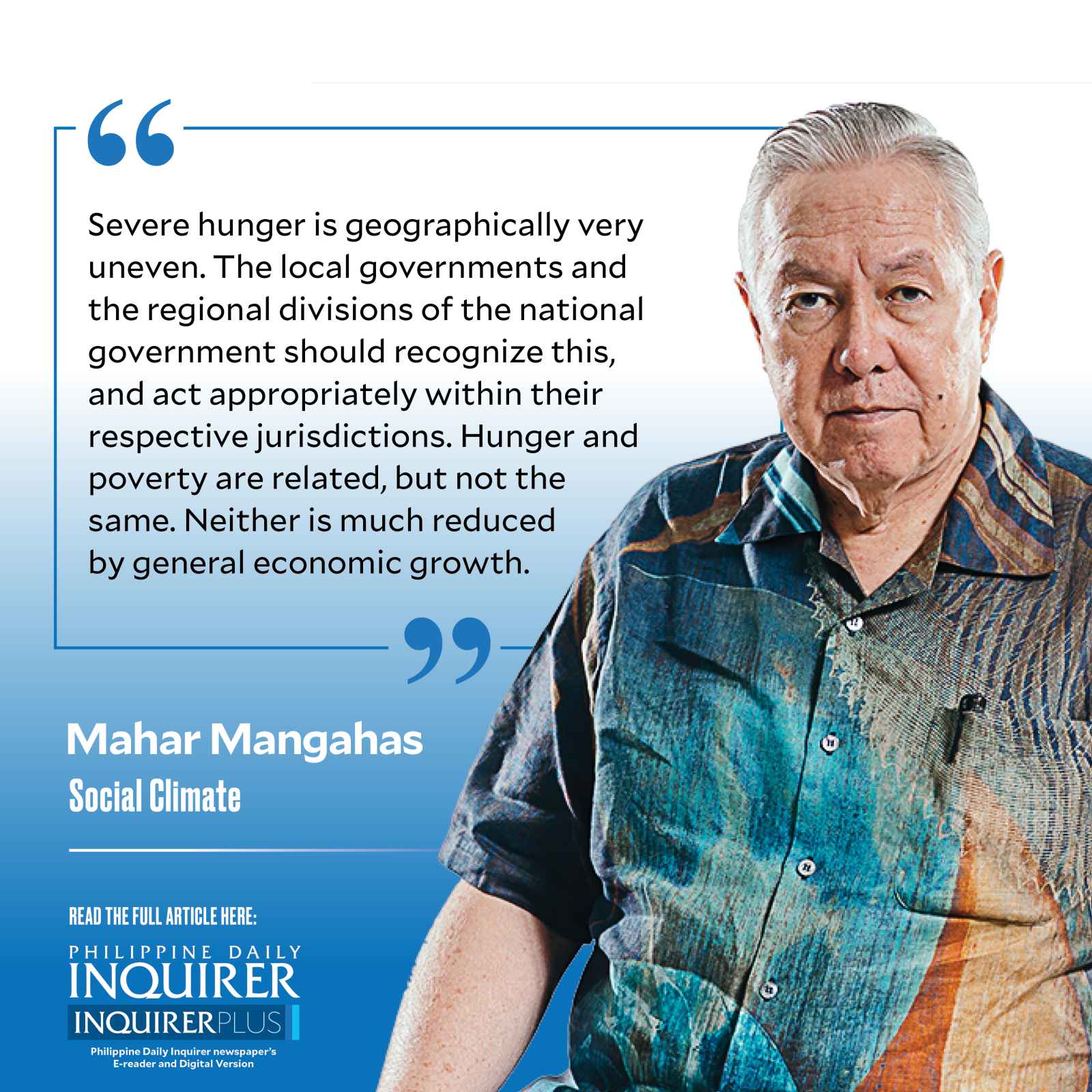Hunger is very stubborn

Despite the recent significant 6-point drop in Self-Rated Poverty (SRP) in 2023Q2—see “Not for the Sona,” (7/29/23)—the incidence of hungry families did not follow suit. On the contrary, hunger rose a bit, as per the Social Weather Stations (SWS) release, “Second Quarter 2023 Social Weather Survey: Hunger rises from 9.8% in March 2023 to 10.4% in June 2023,” www.sws.org.ph, 8/2/23.
The 9.8 hunger rate last March was the first time to be single-digit ever since 2020. Together with the new 10.4 percent this June 2023, the average hunger rate for two quarters of 2023 is 10.1 percent. One may round off both rates to 10 percent, and see a steady national-level hunger rate.
Make sure of the recovery first. The first task should be to recover to pre-COVID times: a full year average of at most 9 percent of families in hunger, consisting of 8 percent moderate hunger (suffered only once or a few times in the past three months), and only 1 percent severe hunger (suffered often or always in that time). Learn the geography of hunger. Every SWS national survey is a consolidation of surveys in the National Capital Region (NCR), Balance Luzon, Visayas, and Mindanao. The two-quarter steadiness of national hunger was due to hunger-increases in NCR (by 5 points) and Balance Luzon (by 3 points), plus hunger drops in Mindanao (by 5 points) and Visayas (fractional). Although within the area-level error margin of 6 points, these numbers indicate special stress in NCR, and some relief in Mindanao.
The June 2023 hunger percentage is highest in NCR (15.7), followed by Balance Luzon (11.3), Visayas (9.3), and Mindanao (6.3). Yet the SRP percentage is lowest in NCR (35), followed by Balance Luzon (39), Mindanao (54), and Visayas (57). Note that the geographical patterns of hunger and poverty are different.
National poverty and hunger rates can, and sometimes do, move in opposite directions over time. It has happened before, and not even very long ago. The last time was in 2021Q4, when the national SRP percentage fell to 43 from 45 in 2021Q3, even though the hunger percentage rose to 11.8 from 10.0 over those two quarters (see “95 hunger surveys since 1998,” 4/2/22).
No need to hunt for the “old” survey reports. Every fresh SWS hunger report has a full-time series from the start of the hunger surveys in 1998. Every fresh SWS poverty report has the counterpart series from the start of the SRP series in 1983. There’s one survey for each point in time, with its respondent families questioned about both poverty and hunger, so that their answers on the two topics can be analyzed together.
Both poor and non-poor families include some hungry, and their hunger changes over time. Hunger is experienced not only by the poor but also by the non-poor (which covers the Borderline Poor plus the Not-Poor). At any one time, the hunger rate of the poor is normally larger than that of the non-poor. From earlier to later times, these hunger rates are not fixed: They can, and do, change among the poor, and also change among the non-poor.
It so happened that recently the hunger percentage rose among the non-poor, from 3.9 in March 2023 to 10.3 in June 2023; this was a very significant change of over +6 points. In that period, the hunger percentage fell among the poor, from 15.4 to 10.8; this was a smaller but also significant change of -4.6 points.
The net effect of these two changes was the statistically insignificant rise in the national hunger percentage from 9.8 to 10.4. Clarifying the hunger changes by poverty status demonstrates that there is no internal contradiction within the series of surveys.
Warning: severe hunger in the nation rose from 1.2 to 2.1 percent, or nearly doubled, in the last two quarters. Total hunger is seemingly steady because most of it, the moderate portion, fell slightly, from 8.6 to 8.3 percent.
The severe hunger percentage, on the other hand, in NCR went from 1.0 to 3.7, while in Balance Luzon it went from 1.0 to 3.0; hence it tripled in Luzon as a whole. It rose only fractionally in Visayas, from 0.7 to 1.0. Fortunately, there is good news in Mindanao, where severe hunger fell from 2.3 to 0.3 percent.
Thus, severe hunger is geographically very uneven. The local governments and the regional divisions of the national government should recognize this, and act appropriately within their respective jurisdictions.
Hunger and poverty are related, but not the same. Neither is much reduced by general economic growth. Both are stymied by inflation in the cost of living, especially that of food. In the past 40 years, poverty has been volatile, yet generally trended downward (“Changes in poverty since 1983,” 5/20/23).
The state of hunger, on the other hand, has not shown long-term progress (“The perennial problem of hunger,” 1/21/23). The “good old days” of single-digit hunger were a long time ago, in 1998-2003. How do we bring them back?
—————-
Contact: mahar.mangahas@sws.org.ph.




















